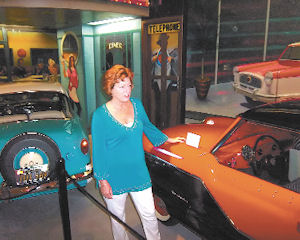When you think of classic cars, the Nash Metropolitan isn’t likely to immediately come to mind. It lacks a big engine and fins on the back. It’s not as instantly recognizable as, say, a Mustang or a Fury or a Cadillac. Yet, the late Jimmy Valentine was so taken with the Metropolitan he based a business around it to serve the collectors who saw some beauty in the little car made between 1953 and 1961. Jimmy Valentine passed away in 2008 and his daughter June continues to operate the Metropolitan Pit Stop on Laurel Canyon Boulevard in North Hollywood. The front portion is a museum for unique models of the Metro. Out back, the mechanics restore the vehicles and replicate some of the moving parts. Outside vendors supply lenses, light bezels, rubber weatherseal and other parts. Foreign customers visiting Los Angeles make a point of stopping by the Pit Stop. They often want to visit the place that originates the spare parts that keep their cars running. “That’s how much they love their car,” June Valentine said. “When people fall in love (with the Metro) it’s head over heels.” Jimmy Valentine had to wait until his three children were out of the house to buy his first Metropolitan. That car is to the immediate left upon entering the museum. Next to it sits a Metro station wagon prototype that was never put into production. Nearby is the Astra-Gnome, a one of a kind vehicle with a bubble top built for the 1956 International Auto Show. Jimmy Valentine found the car in a New York City parking garage. The Metro was not a roomy car. Leg room is practically non-existent. The Pit Stop does sell seat extensions that allow a driver of six feet, two inches to get inside. Above that, forget it. By creating such a small car, Nash (later part of American Motor Co. or AMC) was ahead of its time as American cars of the time tended to be large. Actual production of the vehicle took place in England where smaller cars —the MG and Triumph — were more common. The Metro turned out to be one of the first foreign built cars sold for the U.S. market, Valentine said. “It was a novelty,” she added. That novelty may be part of the allure for collectors who latch onto the Metro as their car of choice. But don’t discount the overall look the Metro presents to the public, or what June Valentine calls “the cuteness” of the car. In a 2005 interview with Hemmings, a car collector publication, Jimmy Valentine said that while other classic cars generate admiration, the Metro brings a smile to the face. “This is a conversation car-that’s part of the charm of it,” Jimmy Valentine said, in the interview. “Every time you go to the gas station or grocery store, you attract conversation.” Jimmy Valentine had been in the music business before getting into the Metro business. He worked for NBC and Capitol Records before opening his own studio in North Hollywood. Valentine phased-out the recording work by the late 1970s, as the car business picked up speed. The Pit Stop came about because Jimmy Valentine had trouble finding spare parts for his cars. Other owners were in the same predicament. So he contacted dealers to buy out their inventories. Later, he contacted a manufacturer to make tail light bezels — 5,000 of them. That move made the family think their father was crazy, June Valentine said, adding, “He took a gamble and he did it.” In her pre-Pit Stop days, June worked as a legal administrator in various law offices. She moved to the family business in 2002 after her mother, Eve, retired due to health reasons. June worked alongside her father until 2006, when he became too sick and she took over more responsibilities. “This was my father’s passion,” Valentine said. “He would have kept working until he was 110.” The suddenness of her father’s illness and death kept June from learning all he could impart to her about running the Pit Stop. While having a management background from the law firms, there were aspects specific to an auto business that required some serious study — learning the mechanics of the Metro, the logistics of getting replacement parts, and dealing with mechanics, she said. June Valentine has owned a Metro since her 20s and continues to drive one to work. On the freeway, however, she stays in the slow lane. June’s daughter, April, works part-time at the Pit Stop, and son Justin has enough interest in the business that he will likely work there within the next year. That assures that the next generation of Valentines will keep Jimmy’s passion rolling along — and the passion of Metro owners around the globe. “People get so excited when they get these cars,” June Valentine said. “They can’t wait to start doing things to it. When you go to a (Metro) club meet you will see all kinds of things.” Staff Reporter Mark Madler can be reached at (818) 316-3126 or by e-mail at [email protected]
